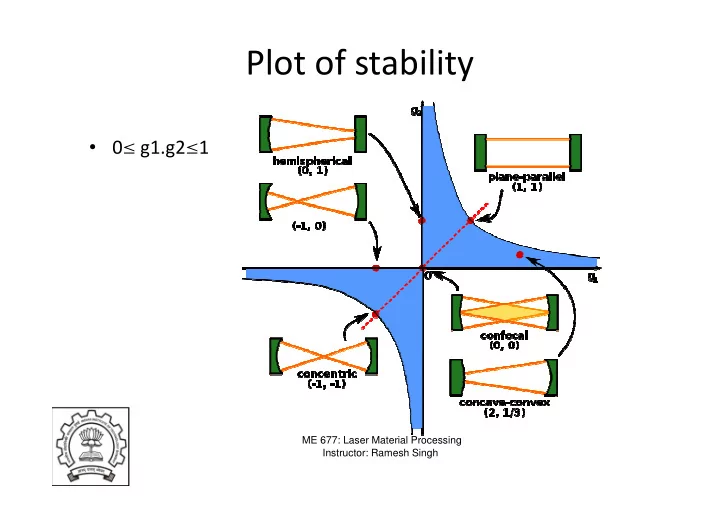

Plot of stability • 0 � g1.g2 � 1 ME 677: Laser Material Processing Instructor: Ramesh Singh
Cavity Length • The cavity length/width of aperture determines number of off-axis modes between the mirrors – L = cavity length – a = radius of aperture – λ = wavelength of laser radiation – n = number of fringes or off axis modes n = number of fringes or off axis modes L+n λ 2a L ME 677: Laser Material Processing Instructor: Ramesh Singh
Fresnel Number • Using Pythagoras Theorem and ignoring higher order terms, ( ) 2 2 2 + = + λ a L L n 2 = λ a 2 Ln 2 a = n λ λ 2 2 L L • n = Fresnel Number/2 • Total number of fringes observed if the back mirror is uniformly illuminated ME 677: Laser Material Processing Instructor: Ramesh Singh
Fresnel No. (Contd.) • Low Fresnel number gives low-order mode • Off axis oscillations are lost in diffraction • A high Fresnel number cavity can be controlled by using mirror design using mirror design – Flatter of Curved? • Off axis modes define Transverse Electromagnetic Mode ME 677: Laser Material Processing Instructor: Ramesh Singh
CO 2 Lasers • The traveling photon formed due to energy loss or collision: – It can take molecule 10 0 0 to 00 0 1 – Get diffracted – Strike the excited molecule at higher energy • The molecule at higher energy will emit photon of identical wavelength in same phase and direction ME 677: Laser Material Processing Instructor: Ramesh Singh
KrF Excimer Laser at IIT Bombay • No oscillator • Very High Powers ( 0.2 J/pulse on 20 ns pulse width) • Expensive • Expensive ME 677: Laser Material Processing Instructor: Ramesh Singh
Fiber Laser at IIT Bombay • 100 W CW • Frequency 100 KHz • Pulse width of the order of s order of µ s ME 677: Laser Material Processing Instructor: Ramesh Singh
Industrial Lasers-Slow Flow • Slow Flow Lasers – Cooling through walls of the cavity • Analysis of cooling in slow flow lasers – Heat generated/length = Q π r 2 – Heat removed/length = -2 π rk(dT/dr) – Q= rate of volumetric heat flow a r ME 677: Laser Material Processing Instructor: Ramesh Singh
Analysis for Slow Flow Lasers Tc a Qr � � = − dT dr 2 k T r = = MaxTemp @ r 0 , T max Taxis 2 Qa = = + + Taxis Taxis Tc Tc 4 k Volumetric _ Heat , P η = Q 2 π a L = πη − P 4 kL ( T max Tc ) ME 677: Laser Material Processing Instructor: Ramesh Singh
Slow Flow-Waveguide Cooling • A variation of conduction route – Thin slit between electrodes is the laser cavity – Laser is wave guided within the narrow passage • Analysis of cooling in slow flow lasers – Heat generated in cross-section A, and thickness, x = Q Α x – Heat removed by conduction = -2kA(dT/dx) Tc x 2g Tc ME 677: Laser Material Processing Instructor: Ramesh Singh
Waveguide Analysis g Tc Qx � � = − dT dx 2 k T x = = MaxTemp @ x 0 , T max Taxis 2 Qg = + Taxis Tc 4 4 k k Volumetric _ Heat , P η = Q A 2 g A = η − P 8 k ( T max Tc ) g ME 677: Laser Material Processing Instructor: Ramesh Singh
Slow-Flow Lasers • Cooling efficiency governs the output power • 50W/m -80 W/m output power • Good mode for rod systems • Elliptical profile and arrayed beams for wave guide • Elliptical profile and arrayed beams for wave guide ME 677: Laser Material Processing Instructor: Ramesh Singh
Fast Axial Flow Lasers • Fast axial flow lasers – Gas flow rates 300-500 m/s in discharge zone – Cavity length is of low Fresnel number – Good for high power compact lasers – Cooling is done by the flowing gas during its time of interaction in discharge zone Courtesy: Steen 3rdEdition ME 677: Laser Material Processing Instructor: Ramesh Singh
Analysis – Fast Axial Flow δ = − Q Q . dt = where Q heat (J) 3 = Q rate of volumetric heat generation ( W/m ) T L c Q dx . � � � � ρ ρ = = − − CdT CdT V V T x P η = Q AL = ηρ − P AVC ( T max Tc ) ME 677: Laser Material Processing Instructor: Ramesh Singh
Fast Axial Flow Lasers • Power is proportional to area and velocity • Mode number a 2 /L �� A/L � is typically very high and difficult to focus finely • Very high power generation – 650 W/m – 650 W/m ME 677: Laser Material Processing Instructor: Ramesh Singh
Transverse Flow Lasers • For very high powers lasers are convectively cooled in transverse direction • Asymmetric beam power due to heating of the gas while traversing the lasing space • Asymmetric beam power is obtained • UTRC 25 KW laser, MLI laser ME 677: Laser Material Processing Instructor: Ramesh Singh
UTRC Laser ME 677: Laser Material Processing Instructor: Ramesh Singh
Solid State Lasers • Solid state lasers have three key design features – Pumping power for lasing – Cooling – Avoiding distortion or breakage due to thermal load • Nd-YAG • Nd-YAG – Pumped by flash lamp or diode – Nd 3+ ions in YAG rod – Q switching for pulse rates (0-50 kHz) • Spoils lasing oscillation in controlled way • Mechanical chopper, bleachable dye, optoelectric shutter, acousto-optic switch ME 677: Laser Material Processing Instructor: Ramesh Singh
Recommend
More recommend